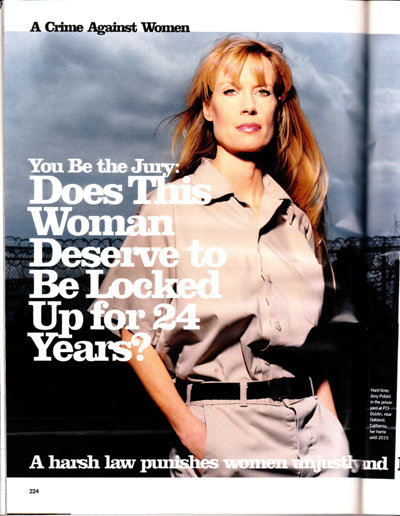
The State of Arkansas rallied behind one of their own to free Amy from a draconian 24-year drug conspiracy sentence
The Conspiracy Case Against Amy Ralston Pofahl
Amy Ralston Pofahl – (now Povah) was indicted, tried and convicted by the federal government in Waco, Texas in 1991. Amy was assigned a court appointed attorney whose only interest was to solicit a guilty plea from her during the one-year timeframe she was held, without bail, in the McLennon county jail in Waco, Texas. The majority of the evidence presented at her trial pertained to her estranged husband, Charles Fredrick “Sandy” Pofahl, but the jury focused on Amy in his absence. Sandy Pofahl was incarcerated in Germany yet was not brought back to the U.S. to testify against his alleged co-conspirators, even though he had entered into a plea agreement with the United States and the chemist, Dr. Key, (also serving time in Germany for the same conspiracy case) was brought back to the United States to testify as part of his plea agreement. There is only one reason why the feds did not want to bring Sandy Pofahl back to testify against Amy – it would have essentially destroyed their case against her – since they portrayed her as someone who was involved in every aspect of the conspiracy from its inception. Dr. Key did not believe Amy was involved or even aware that her husband and Dr. Key were manufacturing MDMA – however, the prosecution asked several questions that built a case against Amy based on one inference after another, such as whether Amy was ever “seen” in Guatemala. Amy traveled with Sandy to Guatemala on three occasions, including one trip that including both sets of parents. While Amy and family was sightseeing, Sandy would often meet with his associates about matters pertaining to his MDMA enterprise, yet left Amy out of those conversations and meetings.
To shed light on the true facts of this case, versus the government’s version which is anchored in testimony from cooperating witnesses, many of whom were discredited during trial, and/or contradicted themselves during their own testimony, please review the following affidavits provided by several co-conspirators, including Charles Pofahl, Dr. Key, Tom Blackburn, Daniel Glass Bernard, Jerry Williamson and Cliff Cowles. Affidavit of Charles “Sandy” Pofahl; Affidavit of Dr. Key; Affidavit of Tom Blackburn; First Affidavit of Daniel Bernard; Second Affidavit of Daniel Bernard; Affidavit of Jerry Williamson; Affidavit of Cliff Cowles;

Glamour magazine was the first major publication that tackled how the conspiracy law ensnares wives and girlfriends, holding them equally culpable for what their significant other did.
Additional people who provided affidavits for Amy’s final appeal include Paul McCaghren, a retired Dallas police officer who met and observed Sandy’s behavior. Paul was a close friend of Amy’s parents dating back to high-school and knew Amy her entire life. He also lived in Dallas, where Amy and Sandy lived, attended their wedding and wanted to testify on Amy’s behalf during her trial, but was shocked that Amy’s attorney never met with him to discuss any of the particulars of her case and, as stated in Paul’s affidavit, “In the course of my career, I have never witnessed an attorney with such bizarre behavior as he [Mr. Hurley] exhibited. Affidavit of Paul McCaghren;
David Ralston is Amy’s cousin who worked at one of Sandy Pofahl’s companies, Commonwealth Credit Corp – later known as Commonwealth Bancorp – a second mortgage home-lending institution. Amy became Vice President of sales after she consistently closed the largest percentage of loans solicited by the sales staff during the first three months of the company’s start-up. David Ralston agreed to testify on behalf of Amy but again, her attorney never even contacted David and he took the witness stand, cold turkey and was unable to establish key aspects that would have portrayed a different image of Amy than the one the government was implying to the jury through testimony of nefarious characters. Most were co-defendants who had entered into plea bargains in an effort to reduce their own sentences and culpability by testifying against Amy who refused to sell her soul by wearing a wire or testify against the vey people who were testifying against her. Some of the people the gov’t wanted Amy to incriminate, she had never met or heard of. Affidavit of David Ralston

Postcard used to help garner support for Amy’s clemency
Many people provided character letters and affidavits for Amy’s post-conviction habeas corpus appeal, but the district court, presided over by the same Judge who sentenced Amy, [Judge Walter Smith] never acknowledged or commented on these affidavits, and merely denied Amy’s motion, without providing any legal basis for the denial. She was then denied the right to appeal her motion to the 5th circuit court of appeals, based on the The Antiterrorism and Effective Death Penalty Act of 1996, (also known as AEDPA) that mandated a “certificate of appealability” to allow petitioners the right to advance their case to a higher court. Essentially, the same Judge and court that presides over a case now has final say as to whether a defendant’s case will ever be viewed by another jurisdiction. Judge Smith denied Amy’s “certificate of appealability” to the 5th Circuit. Although the AEDPA included a provision that the circuit court could override the denial of a certificate of appealability, it is rarely done so, especially if the district court won’t provide any determining facts upon which the circuit court could glean an error had occurred. This blow made Amy realize her only hope was “justice through clemency.”
In the spirit of justice, Amy’s freedom was granted on July 7, 2000 when President Clinton commuted her sentence by granting her clemency petition. Thus – CAN-DO Foundation was born. Amy began advocating for several women she had bonded with in prison, including her roommate, Lau Ching Chin, an Asian woman who only passed one telephone message to a boyfriend, and in doing so, unwittingly ensnared herself in the conspiracy statute that mandated a 17 year sentence. Amy wrote and filed Chin’s clemency petition while they were still roommates, advocated for her after her release and helped secure Chin’s clemency before Clinton left office. Thus – the CAN-DO Foundation was born and became a 501 (c)(3) in 2004.
Update: U.S. District Judge Walter S. Smith Jr. is now the subject of a renewed investigation into allegations that he made unwanted sexual advances toward women in his chambers. He retired, ending his 32-year tenure as federal judge but will receive his full salary of $203,100 as a lifetime appointment.
The Judicial Council of the 5th U.S. Circuit Court of Appeals formally reprimanded Judge Walter Smith in December of 2015, after finding he made ”inappropriate and unwanted physical and nonphysical advances” toward a female courthouse staff member in his court chambers in 1998.














